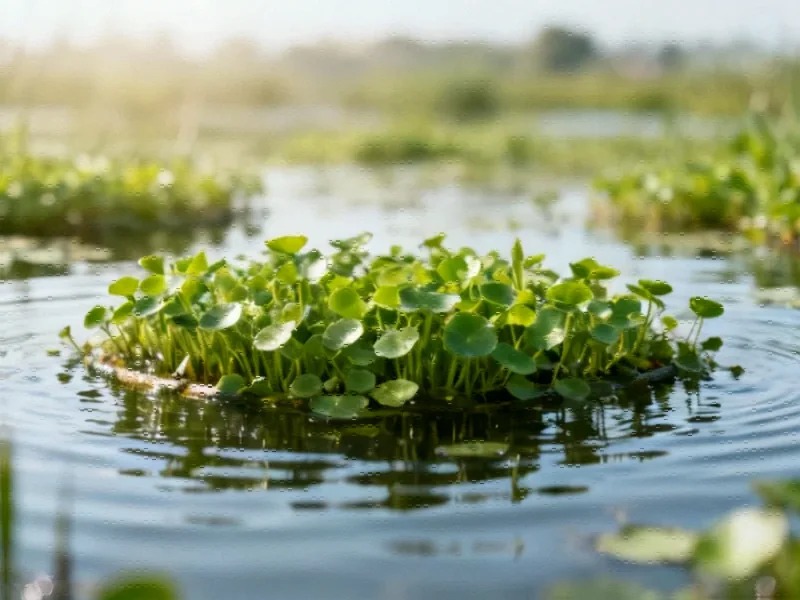The Bio-Engineered Solution to Water Pollution
While engineers have long relied on complex systems and chemicals to treat contaminated water, researchers are discovering that nature’s own filtration systems often outperform even the most sophisticated human designs. At a resource recovery center in Caloundra, Australia, environmental engineer Chris Walker examines a clump of reeds pulled from an artificial floating wetland, their roots coated in nutrient-absorbing biofilm. “We’ve worked out that no matter how hard you engineer something, nature filters everything much better than anything else,” says Professor Simon Beecham from the University of South Australia, who is collaborating with Walker on this innovative project.
Global Applications of Floating Wetland Technology
Artificial floating wetlands are gaining traction worldwide as sustainable solutions for water purification. These systems consist of buoyant platforms made from heavy-duty plastic pods containing fast-growing reeds and other aquatic plants. The plants’ roots extend into the water, where they absorb excess nutrients like nitrogen and phosphorus while providing surface area for beneficial microbial communities.
In Florida, a massive 4,000-square-meter floating wetland helps remove pesticides and nutrients from recreational areas before they can contaminate nearby lagoons. Chicago has transformed industrial sections of its river with floating wetlands featuring attached boardwalks, while elsewhere along the waterway, floating plant beds clean creeks and create habitats for birds and aquatic mammals. The technology has even reached Pakistan, where floating wetlands treat crude oil wastewater, and Canada, where they process domestic wastewater.
The Economics of Natural Water Treatment
What has been missing from the conversation about floating wetlands, according to Walker, is comprehensive economic analysis. A global study quantifying economic benefits of floating wetlands has now demonstrated their cost-effectiveness compared to traditional engineering approaches.
Dr. John Awad, the study’s lead author from CSIRO, explains their findings: “Floating wetlands mimic the functions of natural ecosystems, filtering nutrients and pollutants through plant roots and microbial communities. But until now, there’s been limited data on what they actually cost to build, maintain and operate at scale.”
The research examined 11 floating wetlands worldwide and discovered that larger systems generally achieve lower costs per kilogram of nutrient removal. “Scale matters,” Awad emphasizes. “Climate also plays a role. Wetlands in warmer regions had longer growing seasons and higher pollutant removal rates.”
Technical Considerations and System Longevity
Floating wetlands vary significantly in design and materials. Some utilize natural materials for their floating platforms, requiring replacement every few years, while more durable systems can last two decades or longer. The technology represents a shift in engineering philosophy, moving away from chemical-intensive processes toward biological solutions that work with natural systems.
As these natural treatment systems gain popularity, related innovations in monitoring and control technologies are enhancing their efficiency. The integration of smart systems allows for better management of these ecological solutions, creating synergies between biological processes and technological oversight.
Global Impact and Future Potential
The study highlights floating wetlands as particularly valuable for low- and middle-income countries, where affordable, low-energy treatment systems are urgently needed. Unlike conventional treatment plants that require significant energy inputs and chemical additives, floating wetlands operate primarily through natural biological processes, making them accessible to communities with limited resources.
This approach to water treatment aligns with broader industry developments in sustainable infrastructure. Just as energy storage systems are transforming power management, natural water treatment technologies are revolutionizing how we approach water quality challenges.
The success of floating wetlands also reflects a growing recognition within engineering circles that nature often provides the most efficient solutions. As Beecham notes, “Engineers are working out that nature does a pretty good job by itself. If you can use nature, you’ll come out with a more optimal answer.” This philosophy is spreading across multiple sectors, including recent technology developments that increasingly prioritize efficiency and sustainability.
Implementation Challenges and Maintenance Requirements
Despite their advantages, floating wetlands do present certain challenges. “We’re dealing with heavy pollutants and they come with significant maintenance needs,” Walker acknowledges. The systems require monitoring and occasional plant harvesting to remove captured nutrients from the water ecosystem permanently. However, these maintenance activities are generally less complex and hazardous than handling the chemicals used in traditional treatment systems.
The growing body of research supporting floating wetlands, combined with their demonstrated effectiveness across diverse environments, suggests these natural purification systems will play an increasingly important role in global water management strategies. As communities worldwide face mounting challenges related to water quality and resource constraints, solutions that harness nature’s innate capabilities offer promising pathways toward sustainable environmental management.
This article aggregates information from publicly available sources. All trademarks and copyrights belong to their respective owners.
Note: Featured image is for illustrative purposes only and does not represent any specific product, service, or entity mentioned in this article.



